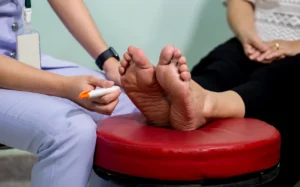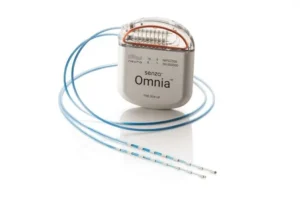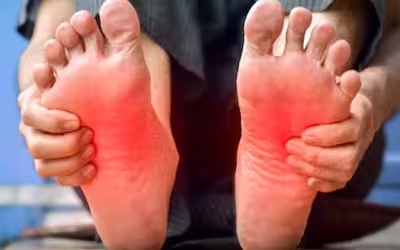HFX for Diabetic Peripheral Neuropathy
HFX Spinal Cord Stimulation for Diabetic Neuropathy
Related Topics:
HFX for Diabetic Foot Pain: A Breakthrough in Neuropathy Treatment with Added Sensation Recovery
Introduction
Diabetic neuropathy is one of the most challenging complications of diabetes, especially when it leads to chronic foot pain. Patients with diabetic neuropathy often experience burning, tingling, and sharp pain in their feet, making daily activities unbearable. Unfortunately, traditional treatments for diabetic foot pain offer limited relief for many individuals. This is where HFX™ (high-frequency spinal cord stimulation) emerges as a promising solution for those suffering from diabetic neuropathy.
At Red Butte Pain Solutions, we understand the impact that diabetic foot pain can have on your quality of life. We offer cutting-edge treatments like HFX™ to help manage your symptoms, restore your comfort, and improve sensation in the feet, which is a major benefit of this therapy.
This article will explore the causes of diabetic foot pain, why traditional treatments often fall short, and how HFX™ offers a revolutionary solution for patients in Arizona—especially with the added advantage of enhanced sensation in the feet.

Understanding Diabetic Neuropathy and Foot Pain
Diabetic neuropathy refers to nerve damage caused by high blood sugar levels over time. As diabetes progresses, elevated glucose levels can harm the nerves, particularly in the legs and feet. About 50% of people with diabetes will develop some form of neuropathy during their lifetime. Of these individuals, a significant portion will experience foot pain that can be debilitating.
Foot pain from diabetic neuropathy typically presents in the following ways:
-
- Burning Sensations
Many people with diabetic neuropathy feel a constant burning pain in their feet. This discomfort can range from mild to severe and often worsens at night. - Tingling and Numbness
A tingling or “pins and needles” sensation often accompanies diabetic foot pain. Some individuals may also experience numbness, making it difficult to detect injuries or infections. - Sharp, Stabbing Pain
Patients frequently describe shooting pains in their feet, which can be sudden and intense. These sharp pains can make walking and standing painful, significantly limiting mobility. - Sensitivity to Touch
Many individuals with diabetic neuropathy become hypersensitive to touch. Even light contact with their feet can trigger pain.
- Burning Sensations
These symptoms not only affect physical health but also have a profound emotional and psychological impact. The fear of worsening symptoms, combined with limited mobility, can lead to feelings of isolation, anxiety, and depression.
Traditional Treatments for Diabetic Neuropathy
Managing diabetic foot pain often involves a combination of medications and lifestyle changes. However, these treatments may not provide adequate relief for everyone, especially as the condition progresses.
-
- Medications
Doctors often prescribe medications to help manage the symptoms of diabetic neuropathy. These can include:- Pain relievers: Over-the-counter medications like acetaminophen and ibuprofen can help manage mild pain.
- Antidepressants: Certain antidepressants, like duloxetine, can help relieve neuropathic pain by altering how the brain processes pain signals.
- Anticonvulsants: Drugs like gabapentin and pregabalin are commonly prescribed for nerve pain. However, these medications can cause side effects such as dizziness, fatigue, and confusion.
- Topical Treatments
Some individuals use topical creams or patches containing lidocaine or capsaicin to provide temporary relief from pain. While these treatments can help, they do not address the underlying nerve damage. - Physical Therapy
Physical therapy can improve mobility and reduce discomfort by increasing circulation to the affected area. However, therapy may not be enough to manage severe pain. - Blood Sugar Control
Tight blood sugar control is critical to slowing the progression of diabetic neuropathy. However, once nerve damage occurs, it becomes difficult to reverse the effects through blood sugar control alone.
- Medications
While these treatments can help reduce pain, many patients continue to struggle with daily discomfort. That’s where HFX™ spinal cord stimulation comes in as an advanced option for managing diabetic foot pain.

What is HFX™ for Diabetic Neuropathy?
HFX™ (formerly known as HF10) is an innovative spinal cord stimulation system that offers long-lasting relief from diabetic foot pain. It is a type of high-frequency spinal cord stimulation (SCS) specifically designed to treat chronic neuropathic pain.
Unlike traditional SCS systems, which deliver low-frequency electrical pulses, HFX™ delivers high-frequency stimulation at 10,000 Hz. This high-frequency stimulation interrupts pain signals traveling from the nerves to the brain, helping to reduce or eliminate the perception of pain.
Added Benefit: Improved Sensation in the Feet
One of the most exciting benefits of HFX™ is the potential for restoring sensation in the feet. While HFX™ primarily aims to alleviate pain, studies have shown that many patients also experience improved sensation after treatment. This increased sensation can significantly enhance the quality of life, especially for those who suffer from numbness or loss of feeling in their feet due to diabetic neuropathy.
Restored sensation offers several key advantages:
-
- Reduced Risk of Injury
Loss of sensation in the feet can make it difficult for individuals to detect cuts, sores, or infections, increasing the risk of serious complications. Restoring sensation helps patients become more aware of potential injuries, allowing for timely care and reducing the likelihood of complications such as ulcers or infections. - Improved Mobility
When patients regain feeling in their feet, they can better maintain their balance and coordination. This often leads to increased confidence in walking and standing, enhancing overall mobility. - Enhanced Quality of Life
Feeling your feet again, combined with pain relief, can drastically improve daily living. Patients often report feeling more in control of their bodies, reducing the anxiety and frustration associated with diabetic neuropathy.
- Reduced Risk of Injury
How Does HFX™ Work?
The HFX™ system works by delivering mild electrical pulses to the spinal cord, which disrupt pain signals traveling from the feet to the brain. This is achieved through a small implantable device, which consists of the following components:
-
- Leads
Thin, flexible leads are implanted near the spinal cord, typically in the lower back region. These leads deliver electrical pulses to the spinal cord, where they interfere with pain signals. - Implantable Pulse Generator (IPG)
The leads are connected to a small pulse generator, which is implanted under the skin, usually in the lower back or buttocks. The IPG sends high-frequency electrical pulses through the leads to the spinal cord. - Remote Control
Patients receive a handheld remote control that allows them to adjust the settings of the device. This gives individuals the flexibility to customize their pain relief based on their daily needs.
- Leads
The HFX™ system is designed to provide continuous pain relief, offering patients significant improvements in their quality of life. Many individuals experience a reduction in pain within days of the procedure, with further improvements over time.
The HFX™ Procedure: What to Expect
The HFX™ procedure is minimally invasive and typically performed in two stages: the trial phase and the permanent implant phase.
-
- Trial Phase
Before committing to a permanent implant, patients undergo a trial phase. This involves temporarily placing the leads near the spinal cord to test the effectiveness of the therapy. The trial usually lasts for about a week. If the patient experiences significant pain relief during this time, they can proceed to the permanent implant. - Permanent Implant
Once the trial phase confirms that the therapy works, the patient undergoes the permanent implantation of the HFX™ system. The leads are positioned near the spinal cord, and the IPG is implanted under the skin. The entire procedure usually takes about one to two hours.
- Trial Phase
After the procedure, patients can return home the same day and begin using their HFX™ system to manage their pain. The recovery period is short, with most patients resuming normal activities within a few days.
Who is a Candidate for HFX™?
HFX™ is an excellent option for individuals with diabetic foot pain who have not found relief from other treatments. Ideal candidates include:
- Patients with chronic pain caused by diabetic neuropathy.
- Individuals who have tried medications, physical therapy, or other treatments without success.
- Patients looking for a long-term solution to manage their foot pain.
- Those who wish to avoid more invasive surgical interventions.
If you are living with diabetic foot pain and seeking a breakthrough treatment, HFX™ could be the solution for you.
Benefits of HFX™ for Diabetic Foot Pain
HFX™ offers several key benefits for patients dealing with diabetic neuropathy:
-
- Effective Pain Relief
HFX™ targets the source of the pain, offering significant and long-lasting relief. Many patients experience an 80-90% reduction in pain, allowing them to return to daily activities with minimal discomfort. - Improved Sensation
One of the most valuable benefits of HFX™ is the restoration of sensation in the feet. By restoring the ability to feel, patients reduce the risk of injuries and improve mobility. - Minimally Invasive
The procedure is minimally invasive and does not require major surgery. Most patients can resume their regular activities within days of the procedure. - No Paresthesia
Unlike traditional spinal cord stimulation, HFX™ does not produce tingling or buzzing sensations, making it more comfortable for patients. - Customizable Pain Relief
The HFX™ system allows patients to adjust their therapy settings to suit their daily needs. This ensures personalized pain relief based on individual preferences. - Improved Quality of Life
With effective pain management and improved sensation, many patients regain their ability to walk, stand, and participate in activities they once enjoyed. The reduction in pain also improves sleep, mood, and overall well-being.
- Effective Pain Relief
Call us at 602-633-4334 or Click Below
Overcoming Complex Regional Pain Syndrome: Resilience and Recovery
Complex Regional Pain Syndrome (CRPS) is a perplexing and often debilitating condition. It can turn a minor injury into a chronic...
Fighting Diabetic Neuropathy: A Personal Journey
Diabetic Neuropathy: A Pathway to Loss About 12 years ago, I lost my cousin, well, technically my mother's cousin, to complications from diabetes. He was a funny, gregarious, larger-than-life individual who always made me laugh, gave sage advice, and was fun to be...
Spinal Stenosis: Pathways to Relief
Spinal stenosis is a common condition that affects many people, especially as they age. If you're experiencing back pain and are unsure of the cause, it might be due to spinal stenosis. At Red Butte Pain Solutions in Chandler, Arizona, we specialize in diagnosing and...
Understanding and Treating Diabetic Peripheral Neuropathy at Red Butte Pain Solutions
Living with diabetic peripheral neuropathy, often referred to as diabetic nerve pain, can be incredibly challenging. At Red Butte Pain Solutions, located in Chandler, Arizona, we understand the unique struggles faced by those in our community dealing with this...
Failed Back Surgery Syndrome (FBSS) at Red Butte Pain Solutions
Understanding Failed Back Surgery Syndrome (FBSS) Have you had back surgery but still feel pain? You might have what is called Failed Back Surgery Syndrome, or FBSS. This happens when back or spine surgery doesn't reduce pain or leads to new pain. At Red Butte Pain...
Call us at 602-633-4334 or Click Below

